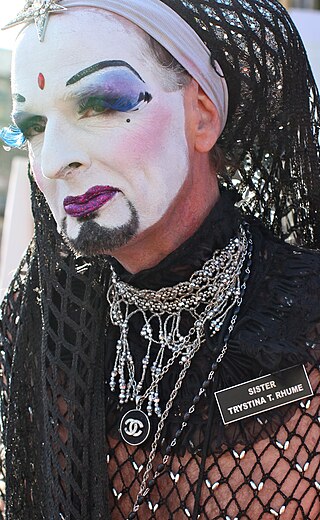Sissy, also sissy baby, sissy boy, sissy man, sissy pants, etc., is a pejorative term for a boy or man who does not demonstrate masculine traits, and shows possible signs of fragility. Generally, sissy implies a lack of courage, strength, athleticism, coordination, testosterone, male libido, and stoicism. A man might also be considered a sissy for being interested in typically feminine hobbies or employment, displaying effeminate behavior, being unathletic or being homosexual.

Butch and femme are masculine (butch) or feminine (femme) identities in the lesbian subculture which have associated traits, behaviors, styles, self-perception, and so on. This concept has been called a "way to organize sexual relationships and gender and sexual identity". Butch–femme culture is not the sole form of a lesbian dyadic system, as there are many women in butch–butch and femme–femme relationships.

Masculinity is a set of attributes, behaviors, and roles associated with men and boys. Masculinity can be theoretically understood as socially constructed, and there is also evidence that some behaviors considered masculine are influenced by both cultural factors and biological factors. To what extent masculinity is biologically or socially influenced is subject to debate. It is distinct from the definition of the biological male sex, as anyone can exhibit masculine traits. Standards of masculinity vary across different cultures and historical periods.

Femininity is a set of attributes, behaviors, and roles generally associated with women and girls. Femininity can be understood as socially constructed, and there is also some evidence that some behaviors considered feminine are influenced by both cultural factors and biological factors. To what extent femininity is biologically or socially influenced is subject to debate. It is conceptually distinct from both the female biological sex and from womanhood, as all humans can exhibit feminine and masculine traits, regardless of sex and gender.
Effeminacy or male femininity is the embodiment of feminine traits in boys or men, particularly those considered untypical of men or masculinity. These traits include roles, stereotypes, behaviors, and appearances that are socially associated with girls and women. Throughout history, men considered effeminate have faced prejudice and discrimination. Gay men are often stereotyped as being effeminate, and vice versa. However, femininity, masculinity, and other forms of gender expression are independent of sexual orientation.
In sociology, homosociality means same-sex relationships that are not of a romantic or sexual nature, such as friendship, mentorship, or others. Researchers who use the concept mainly do so to explain how men uphold men's dominance in society.
Gender expression, or gender presentation, is a person's behavior, mannerisms, and appearance that are socially associated with gender, namely femininity or masculinity. Gender expression can also be defined as the external manifestation of one's gender identity through behavior, clothing, hairstyles, voice, or body characteristics. Typically, people think about a person's gender expression in terms of masculinity and femininity, but there are many ways to mix both feminine and masculine in identity. A person's gender expression may or may not match their assigned sex at birth. This includes gender roles, and accordingly relies on cultural stereotypes about gender. It is distinct from gender identity.

A gender bender is a person who dresses up and presents themselves in a way that defies societal expectations of their gender, especially as the opposite sex. Bending expected gender roles may also be called a genderfuck.
A soft butch, or stem (stud-fem), is a lesbian who exhibits some stereotypical butch traits without fitting the masculine stereotype associated with butch lesbians. Soft butch is on the spectrum of butch, as are stone butch and masculine, whereas on the contrary, ultra fem, high femme, and lipstick lesbian are some labels on the spectrum of lesbians with a more prominent expression of femininity, also known as femmes. Soft butches have gender expressions of women, but primarily display masculine characteristics; soft butches predominantly express masculinity with a touch of femininity.
Gender variance or gender nonconformity is behavior or gender expression by an individual that does not match masculine or feminine gender norms. A gender-nonconforming person may be variant in their gender identity, being transgender or non-binary, or they may be cisgender. In the case of transgender people, they may be perceived, or perceive themselves as, gender-nonconforming before transitioning, but might not be perceived as such after transitioning. Transgender adults who appear gender-nonconforming after transition are more likely to experience discrimination.
Childhood gender nonconformity (CGN) is a phenomenon in which prepubescent children do not conform to expected gender-related sociological or psychological patterns, or identify with the opposite sex/gender. Typical behavior among those who exhibit the phenomenon includes but is not limited to a propensity to cross-dress, refusal to take part in activities conventionally thought suitable for the gender and the exclusive choice of play-mates of the opposite sex.

The questioning of one's sexual orientation, sexual identity, gender, or all three is a process of exploration by people who may be unsure, still exploring, or concerned about applying a social label to themselves for various reasons. The letter "Q" is sometimes added to the end of the acronym LGBT ; the "Q" can refer to either queer or questioning.
Gender schema theory is a cognitive theory to explain how individuals become gendered in society, and how sex-linked characteristics are maintained and transmitted to other members of a culture. The theory was formally introduced by Sandra Bem in 1981. Gender-associated information is predominantly transmuted through society by way of schemata, or networks of information that allow for some information to be more easily assimilated than others. The theory argues that there are individual differences in the degree to which people hold these gender schemata. These differences are manifested via the degree to which individuals are sex-typed.
Androgyny is the possession of both masculine and feminine characteristics. Androgyny may be expressed with regard to biological sex, gender identity, or gender expression.
Gender systems are the social structures that establish the number of genders and their associated gender roles in every society. A gender role is "everything that a person says and does to indicate to others or to the self the degree that one is either male, female, or androgynous. This includes but is not limited to sexual and erotic arousal and response." Gender identity is one's own personal experience with gender role and the persistence of one's individuality as male, female, or androgynous, especially in self-awareness and behavior. A gender binary is one example of a gender system.
The sexual orientation hypothesis is a hypothesis proposed by Donald McCreary in 1994 that attempts to explain the impact of gender stereotypes on judgments about sexual orientation. This hypothesis states that feminine men are more likely to be assumed gay than masculine women are to be assumed lesbians. This model asserts a broad tendency to associate gender-atypical behavior in men with homosexuality. This is combined with a stigmatization of behaviors held as signs of same-sex attraction in men, and reinforces a stronger culture of exclusive homophobia than among young women.
In Thailand, one can find several different gender roles, identities and diverse visual markers of masculinity and femininity. Beyond the traditional male and female roles, there are categories for individuals who are gender non-conforming, whether in looks or behavior. These are generally regarded as sub-types of each sex, rather than a distinct gender identity, and correlate strongly with homosexuality. Demand and support for positive self-identity is growing in Thailand.

Dude, You're a Fag: Masculinity and Sexuality in High School is a 2007 book by the sociologist C. J. Pascoe. Through ethnographic research, Pascoe examines masculinity in high schools. Pascoe's work proposes that masculinity is defined primarily through dominance and control. Further, masculinity is established by high school boys through their use of the fag (faggot) epithet. This book explores masculinity as enacted by male and female students, the consequences of a strict gender system, heteronormativity within the school system, racialized masculine ideals, and acts of resistance to the gendered social order. Pascoe conducted fieldwork for a year and a half at "River High School", conducted formal interviews with fifty students, and informal interviews with many other students, administrators and faculty members.
Gender policing is the imposition or enforcement of normative gender expressions on an individual who is perceived as not adequately performing, through appearance or behavior, their gender or sex that was assigned to them at birth. According to Judith Butler, rejection of individuals who are non-normatively gendered is a component of creating one's own gender identity. Gender mainstreaming is a public policy concept, whereas gender policing is a more general social phenomenon.
Gender roles in non-heterosexual communities are a topic of much debate; some people believe traditional, heterosexual gender roles are often erroneously enforced on non-heterosexual relationships by means of heteronormative culture and attitudes towards these non-conformative relationships.











